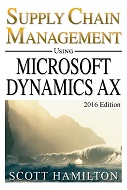Summarizing the SCM changes in Microsoft Dynamics AX 2012 R2
The R2 release for Dynamics AX 2012 included several significant changes in software functionality for supply chain management, especially for the formula approach to product structure. This article summarizes the proportionate magnitude of these R2 changes, and briefly describes the impact of the new capabilities. Subsequent articles will provide more detailed explanations and illustrative case studies to help accelerate the incremental learning of AX professionals. As this series will reveal, the new capabilities broaden the functional footprint of Dynamics AX, allowing customers to replace manual or non-integrated approaches with an integrated solution.
Quantifying the R2 Changes
This article extends a previous analysis about the incremental SCM functionality within AX 2012 in comparison to AX 2009, which was based on my book about Food Products Manufacturing using Microsoft Dynamics AX 2012. The previous analysis employed a heat map (based on page count metrics) to highlight the proportionate magnitude of changes, and this article employs the same metrics for incremental R2 changes. The heat map displayed in Figure 1 summarizes the book's topics, and a bar chart portrayal of previous functionality within AX 2009 (shown in light grey) and the incrementally new functionality within AX 2012 (shown in dark grey) and AX 2012 R2 (shown in black). The entire length of a bar represents a complete walkthrough of the topic using AX 2012 R2, so you get a proportionate magnitude of changes.

Figure 1 Heat Map for Incremental Learning of Dynamics
AX 2012 R2
The yardsticks within Figure 1 indicate the scope and magnitude of R2 changes, as shown by the black shading in the bar chart. The R2 changes primarily impact four topics - about formulas, batch tracking considerations, batch orders, and master planning within S&OP -- and represent a total incremental change of approximately 1%. The major changes are listed below, and subsequent articles provide more detailed explanations.
- Lot inheritance of batch attributes and shelf life dates for manufactured items.
- Potency management, including batch attributes for potency, potency-based prices for purchased items, and potency-based formulas and batch balancing for manufactured items.
- Production sequencing of planned orders for manufactured items.
Differentiating the Formula versus BOM Approach to Product Structure
The incremental R2 changes primarily apply to the formula approach to product structure (rather than the BOM approach), and further differentiate the two approaches to product structure. As described in a previous article, the formula approach also supports a yield percentage, a formula size and multiple substitute ingredients, catch weight items, co/by-products of the production process, planning items (where the production process only results in co/by products), and the synchronization of batch orders for a bulk item and its related packed items.
Typical Business Process for Defining an Item's Formula
Several of the new R2 capabilities impact the typical business process for defining an item's formula, as summarized in Figure 2 and described below.[1] The figure highlights the two additional options for formula variations (via shading) to support lot inheritance and potency-based formulas.

The typical business process for defining an item's formula consists of several steps typically performed by a product designer role. As a starting point, the product designer selects the desired item and creates a new formula version for the item, either by creating a new master formula or by assigning an existing master formula. The formula version policies include the formula size and effectivity dates. Each formula line identifies an ingredient and the required quantity. When applicable, a formula line can define an allowable substitute for an ingredient, the lot inheritance policies, and/or the ingredient type for potency-based formulas. Additional information can also be specified about the expected co/by-products of the production process, if any. Upon completion of all information, the product designer approves and activates the item's formula version.
The R2 changes provide two additional options for formula lines (as summarized below), and subsequent articles will provide more detailed explanation. Those options are:
- Define Formula Lines for Lot Inheritance The product designer uses a formula line to identify an ingredient and its lot inheritance policies for shelf life dates and/or batch attributes. The policies can apply to the end-item or co-products, if any.
- Define Formula Lines for a Potency-Based Formula The product designer uses a formula line to identify an ingredient, the ingredient type and the required quantity to produce the formula size. The ingredient type for a formula line - with choices consisting of active, compensating, filler and none - provides the basis for calculating the ingredient quantity on a batch order based on actual potency. When defining a formula line, the required quantity reflects the target potency for the active ingredient, and it can be expressed in different ways such as a quantity or percentage.
[1] The figure represents one example drawn from a comprehensive set of business processes for using Dynamics AX in several industries (including food products, discrete manufacturing and retail) that is available within the RapidValue tool from Columbus. See the ColumbusGlobal website for additional information about RapidValue.
FREE Membership Required to View Full Content:
Joining MSDynamicsWorld.com gives you free, unlimited access to news, analysis, white papers, case studies, product brochures, and more. You can also receive periodic email newsletters with the latest relevant articles and content updates.
Learn more about us here





